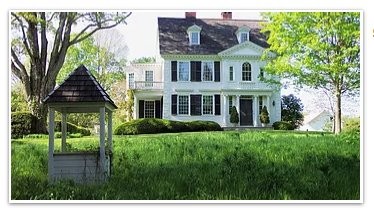Bellamy-Ferriday House & Garden
Introduction
Text-to-speech Audio
The house was constructed between the years of 1754 and 1767 for Reverend Joseph Bellamy, a pastor and educator. Bellamy was one of the leading theologians during the First Great Awakening of the 1740s and 1750s. The First Great Awakening, also known as the Evangelical Revival, was a series of Christian revivals that were popular in Britain and the first thirteen North American colonies through the 1730s and 1740s. Bellamy purchased 104 acres of land for his house in 1738 on the north side of what is known as Bethlehem Village, but it used to be called the North Purchase of Woodbury. He became the North Purchase’s first settled minister.
Images
The Bellamy-Ferriday House basking in the sunlight surrounded by acres of trees.

Backstory and Context
Text-to-speech Audio
The construction of the house started out as an ell that would be built in 1754. Bellamy and his family would live in this ell while the main house was being built. The ell had no chimney which means they did not have an adequate means of fire for cooking and heating their temporary home. The main house was built around 1760 where his family would move into the main home. Later on, the house would be passed on to Bellamy’s son, David, after he passed away in 1790 staying under ownership of the Bellamy Family until 1868. In 1880, another family known as the Hull Family purchased the home and made updates to it with the addition of bay windows and a veranda which gave the building a more Victorian appearance.
In 1912, Henry Ferriday decided to buy the house as a summer home for his family. The family updated the house with many modern utilities like heat and electricity. Ferriday’s wife and daughter, Eliza and Caroline, made a garden consisting of roses, peonies, tulips, lilacs, and many other flower types. Soon, ownership passed down to Caroline until her death in 1990 and written in her will that the house be turned into a museum. Her wish would be granted as the house was transformed and opened as a museum by the Antiquarian and Landmarks Society (later known as Connecticut Landmarks.)
The museum had many exhibits showing off old American and European antiques as well as the the garden created by the Ferriday women. A weeping willow statue is also located at the house and it used to be standing above the grave of French military general Napoleon Bonaparte.
Sources
A Better Home and Garden for Bethlehem, Connecticut History. Accessed May 4th 2021. https://connecticuthistory.org/a-better-home-and-garden-in-bethlehem/.
Kelly, Martha Hall. Caroline Ferriday And Her Infinitely Generous Family, Connecticut Explored. Fall 2019. Accessed May 4th 2021. https://www.ctexplored.org/caroline-ferriday-and-her-infinitely-generous-family/.
https://connecticuthistory.org/a-better-home-and-garden-in-bethlehem/
